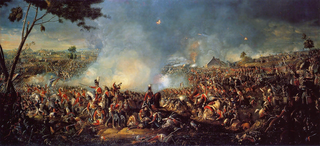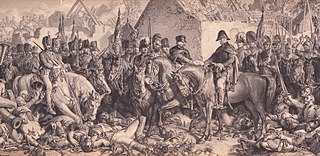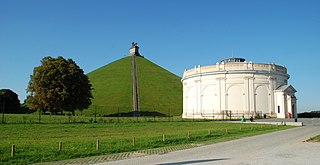 W
WThe 28th Regiment at Quatre Bras is an oil painting on canvas from 1875, painted by Elizabeth Thompson. The painting is 97.2 centimeters (38.3 in) high and 216.2 centimeters (85.1 in) wide. It is in the National Gallery of Victoria, Melbourne, Australia.
 W
WAllegory of Waterloo, also known as Triumph of the Duke of Wellington or the Triumph of Great Britain after the Battle of Waterloo, was a monumental painting by British artist James Ward, completed in 1821, and now lost.
 W
WThe Battle of Waterloo is an oil on canvas by William Sadler II made in June 1815.
 W
WThe Battle of Waterloo: The British Squares Receiving the Charge of the French Cuirassiers is an 1874 oil painting by French artist Henri Félix Emmanuel Philippoteaux. It depicts a scene from the Battle of Waterloo on 18 June 1815, with squares of red-coated infantry from Sir Thomas Picton's British 5th Division to the left being charged by cavalrymen of the French 5th and 10th Cuirassiers in blue uniforms to the right. The main British unit is one of Highland infantry, with the colour party and a mounted officer taking refuge in the centre of the square. Abandoned cannon lie in the foreground and middle distance. It measures 99 × 155 centimetres (39 × 61 in).
 W
WThe Chelsea Pensioners reading the Waterloo Dispatch, originally entitled Chelsea Pensioners Receiving the London Gazette Extraordinary of Thursday, June 22, 1815, Announcing the Battle of Waterloo, is an oil painting by David Wilkie, commissioned by Arthur Wellesley, 1st Duke of Wellington in August 1816.
 W
WThe Meeting of Wellington and Blücher after the Battle of Waterloo is a monumental wall painting by Irish painter Daniel Maclise, completed in 1861. It depicts the moment towards the end of the Battle of Waterloo on 18 June 1815, when the commanders of the allied British and Prussian armies, the Duke of Wellington and Marshal Blücher, met near La Belle Alliance. Measuring 3.68 by 13.92 metres, it is displayed in the Royal Gallery at the Palace of Westminster.
 W
WThe Panorama of the Battle of Waterloo is a rotunda in Belgium that houses a monumental panoramic painting depicting the Battle of Waterloo. The neoclassical building is located immediately to the north of the Lion's Mound on the battlefield of the Battle of Waterloo in the municipality of Braine-l'Alleud in the Belgian province of Walloon Brabant.
 W
WScotland Forever! is an 1881 oil painting by Lady Butler depicting the start of the charge of the Royal Scots Greys, a British heavy cavalry regiment that charged with other British heavy cavalry at the Battle of Waterloo in 1815. The painting has been reproduced many times and is considered an iconic representation of the battle itself, and of heroism more generally.